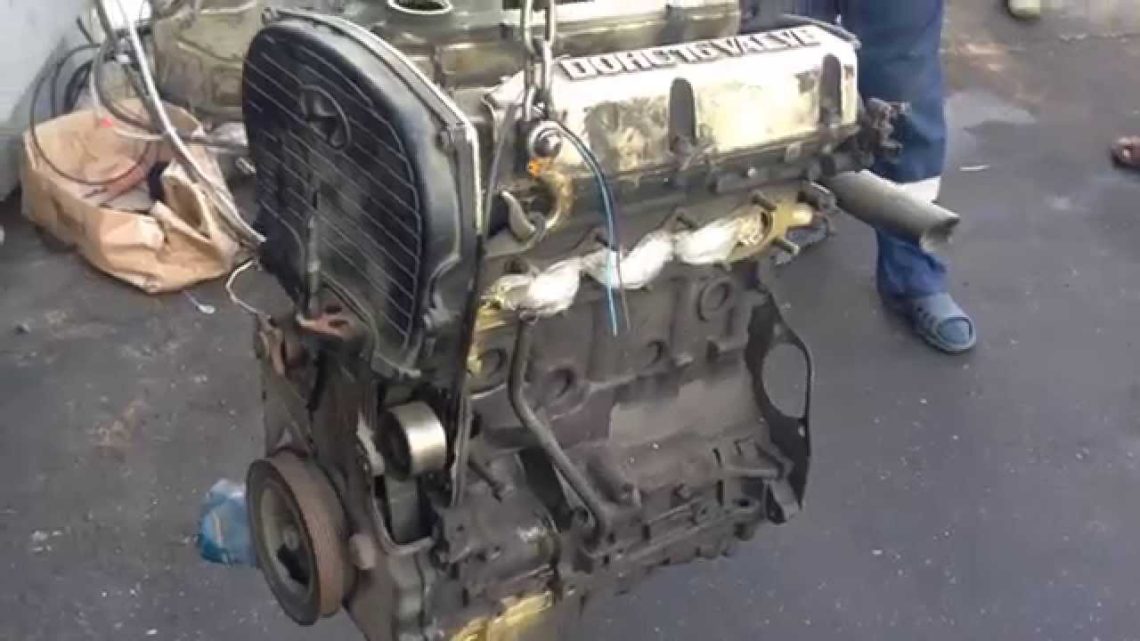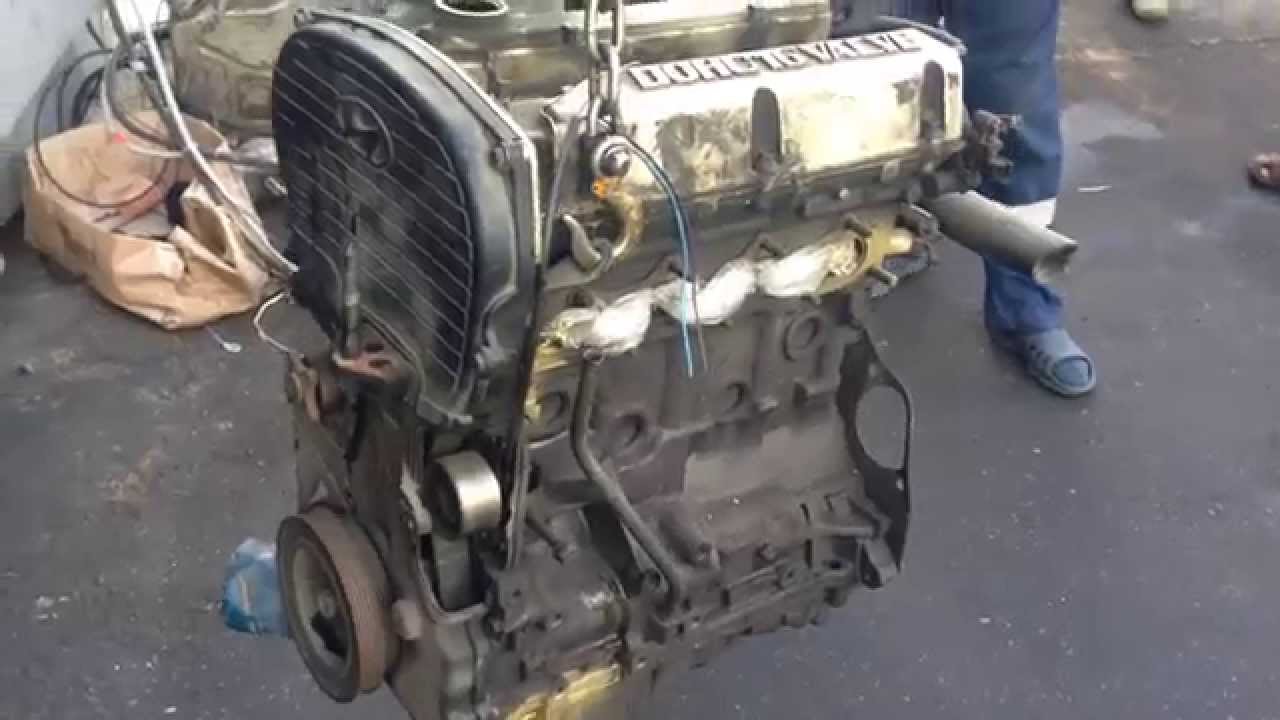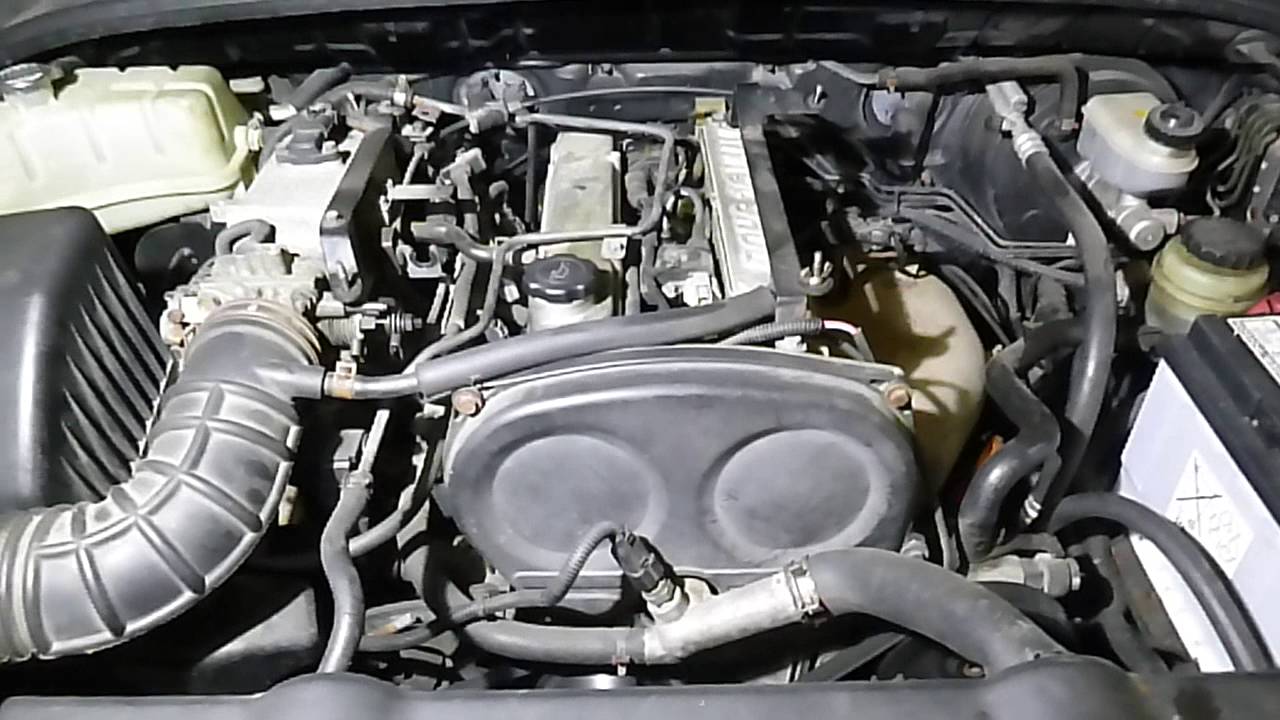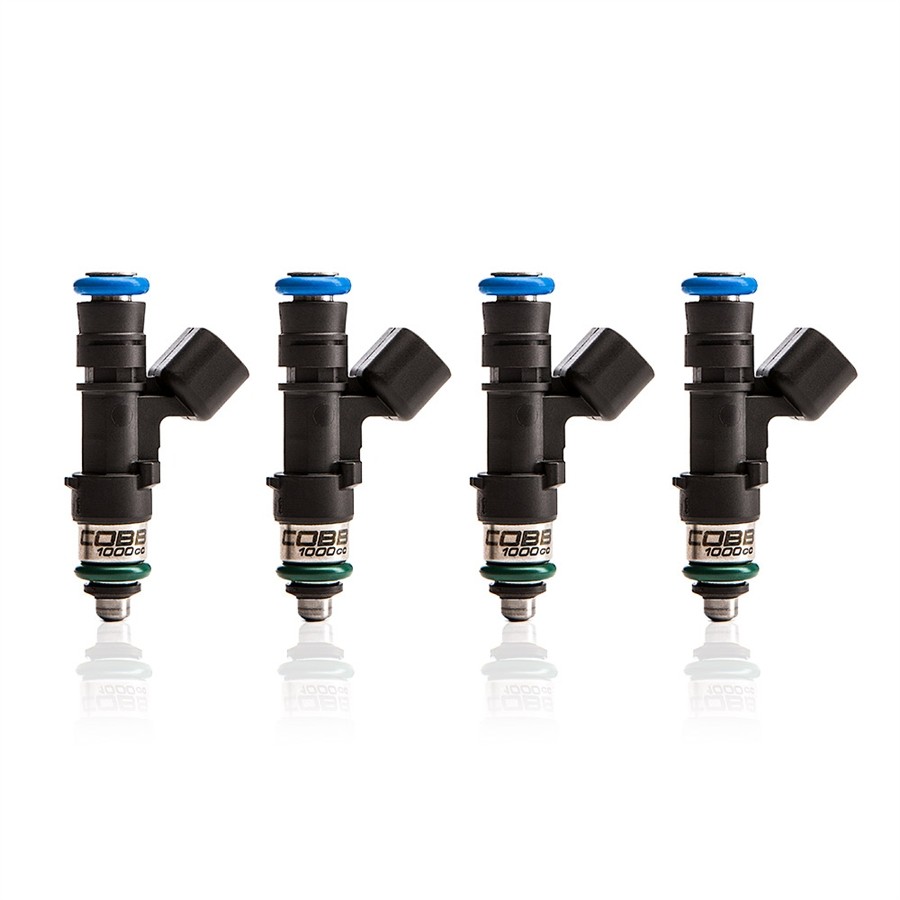
Hyundai G4JS engine
Content
The Korean manufacturer Hyundai did not develop the G4JS engine from scratch, but copied the design from the Mitsubishi 4G64. The Japanese motor has gone through several restylings - it was equipped with 1 and 2 camshafts, 8/16 valves. Hyundai chose the most advanced system - DOHC 16V.
Description of the G4JS engine

A two-shaft gas distribution scheme with 16 valves functioned on a belt drive. The latter could not ensure the safety of the valves; when they broke, they bent, since there are no counterbores in the pistons. Such parts break the valve stems pretty quickly.
The latest version 4G64 was not chosen in vain. It initially increased power, providing maximum KM. An important feature of this motor is also the presence of automatic adjustment of thermal valve clearances. The presence of hydraulic compensators eliminates the need to adjust complex mechanisms each time.
The in-line ICE scheme provided compact dimensions. The motor easily fit under the hood of a car, did not take up much space. In addition, such a unit is easy to maintain and repair. For example, the overhaul of other engines is very difficult to do on your own, but on the G4JS it is easy to do.
Consider other features of the installation:
- the cylinder head is made of dural material;
- intake manifold silumin;
- cooling was done initially with high quality, the motor always receives a sufficient amount of refrigerant;
- the oil system works according to a forced scheme;
- the ignition system uses 2 coils, each supporting two cylinders;
- Both camshafts are driven by the same toothed belt.
| Manufacturer | Hyundai |
| ICE brand | G4JS |
| Years of production | 1987 – 2007 |
| Volume | 2351 cm3 (2,4 L) |
| Power | 110 kW (150 hp) |
| Torque torque | 153 Nm (at 4200 rpm) |
| The weight | 185 kg |
| Compression ratio | 10 |
| Food | injector |
| Motor type | inline gasoline |
| Ignition | DIS-2 |
| Number of cylinders | 4 |
| Location of the first cylinder | TBE |
| Number of valves per cylinder | 4 |
| Cylinder head material | aluminum alloy |
| Intake manifold | Silumin |
| An exhaust manifold | cast iron |
| Camshaft | cast |
| Cylinder block material | cast iron |
| Bore | 86,5 mm |
| Pistons | aluminum casting |
| Crankshaft | cast iron casting |
| Piston stroke | 100 mm |
| Fuel | AI-92 |
| Environmental standards | Euro-3 |
| Fuel consumption | highway - 7,6 l / 100 km; combined cycle 8,8 l/100 km; city - 10,2 l / 100 km |
| Oil consumption | Xnumx l / xnumx km |
| What kind of oil to pour into the engine by viscosity | 5W30, 5W40, 0W30, 0W40 |
| Oil for G4JS by composition | synthetics, semi-synthetics |
| Engine oil volume | 4,0 l |
| Working temperature | 95° |
| Internal combustion engine resource | claimed 250000 km, real 400000 km |
| Adjustment of valves | hydraulic compensators |
| Cooling system | forced, antifreeze |
| Coolant volume | 7 l |
| water pump | GMB GWHY-11A |
| Candles on G4JS | PGR5C-11, P16PR11 NGK |
| Candle gap | 1,1 mm |
| Timing belt | INA530042510, SNR KD473.09 |
| The order of the cylinders | 1-3-4-2 |
| Air filter | Japan Parts 281133E000, Zekkert LF1842 |
| The oil filter | Bosch 986452036, Filtron OP557, Nipparts J1317003 |
| Flywheel | Bow 415015410, Jakoparts J2110502, Aisin FDY-004 |
| Flywheel Bolts | М12х1,25 mm, length 26 mm |
| Valve stem seals | manufacturer Goetze |
| Compression | from 12 bar, difference in adjacent cylinders max. 1 bar |
| Turnovers XX | 750 - 800 min-1 |
| Tightening force of threaded connections | candle - 17 - 26 Nm; flywheel - 130 - 140 Nm; clutch bolt - 19 - 30 Nm; bearing cover - 90 - 110 Nm (main) and 20 Nm + 90 ° (connecting rod); cylinder head - four stages 20 Nm, 85 Nm + 90° + 90° |
Service

The G4JS engine requires timely maintenance and replacement of consumables and technical fluids.
- It is recommended to update the oil every 7-8 thousand km for the performance of a complex plunger pair of hydraulic lifters.
- Change the coolant after 25-30 thousand kilometers, not later, since on this engine the coolant quickly loses its useful properties.
- Clean the crankcase ventilation openings every 20 thousand kilometers.
- Update filters (fuel, air) every 20-30 thousand km.
- Change the water pump and drive belts every 50 thousand kilometers.
Malfunctions
Despite the fact that the G4JS intake manifold is cast, it is short and starts to burn out after 70-80 thousand kilometers. There are other common problems with this motor.
- Float turns on the twentieth. As a rule, this indicates the failure of the sensor that regulates the speed. It is also possible that the damper is clogged, the temperature sensor is broken, or the nozzles are clogged. Solution: replace the IAC, clean the throttle, replace the heat sensor or clean the injector.
- Strong vibrations. They appear for several reasons. Most likely, the engine mounts have worn out. Most often, the left cushion wears out on the G4JS.
- Timing belt break. As mentioned above, this is fraught with potential risks. The reason for the break is connected on this motor with pieces of broken balancers getting under the timing belt. To prevent this from happening again, you need to fill in only high-quality oil, regularly check the balancers or simply remove them. In addition, they introduce unnecessary knocks and clatter into the engine after a run of 50 thousand km.

G4JS modifications
It is considered to be a modification of this engine 2-liter engine G4JP. Between these two motors, almost everything is identical, including the cylinder head and attachments. However, there are also differences.
- The engine size of the G4JS is higher. The piston stroke is also higher by 25 mm.
- The cylinder diameter is 86,5 mm, while the modified version has 84 mm.
- Higher is also the torque.
- G4JP is weaker than G4JS by 19 hp. With.
Cars on which it was installed
These motors were equipped with several Hyundai models:
- universal minivan Stareks Ash1;
- cargo-passenger and cargo van Аш1;
- family crossover Santa Fe;
- Grandeur business class sedan;
- front-wheel drive class E sedan Sonata.
Also, these internal combustion engines were installed on Kia and Chinese models:
- Sorrento;
- Cherie Cross;
- Tiggo;
- Great Wall Hover.
Modernization
G4JS is initially equipped with a tuned VC. This is already a big plus, considering also the twin-shaft scheme, which is ideal for modernization. First of all, let's consider how the standard, atmospheric tuning of this unit is carried out.
- VK channels are polished, their lengths are aligned.
- The factory throttle changes to Evo, a cold intake is installed.
- Viseco pistons, Egli connecting rods are installed, which increases compression to 11-11,5.
- All balancing shafts are removed, more productive ready-made or homemade alloy steel studs are installed.
- A Galant fuel rail with high-performance 450cc injectors is installed.
- A high-performance Valbro fuel pump is installed, pumping 255 liters of gasoline per hour.
- The exhaust size is increased to 2,5 inches, the exhaust manifold is changed to the "Spider" type.

Such changes will lead to an increase in engine power to 220 hp. With. True, it will be necessary to reinstall the ECU program.
If such indicators are not satisfactory, you will have to equip the motor with a classic turbine or compressor.
- It will be better to use the cylinder head from Lancer Evolution, and not to select separate boost kits. Everything is already provided on this head, including expensive components and mechanisms. There is a turbine and an intercooler, an intake manifold and a fan.
- It will be necessary to modify the oil supply to the turbine.
- It is also necessary to replace the native camshafts with similar ones with 272 phases.
- The compression ratio should not be increased, it is enough to have 8,5 units. Under these parameters, you need to select the pistons.
- A reinforced SHPG should be installed. Forged Egli proved to be the best, since conventional cast options are unlikely to cope with increased loads.
- We'll have to put in a more efficient fuel pump - the same Walbro will do.
- You will also need nozzles from Lancer Evo.

In this way, it will be possible to increase the power of the unit to 300 horses. However, this will affect the resource of the motor, which will go down sharply. Scheduled maintenance should be carried out as often as possible.
Final verdict
By incorporating balance shafts that effectively dampen vibrations and torque effects, the G4JS engine must be very reliable. However, this advantage is offset by the constant breaks in the attachment belts - their parts fall under the timing belt, breaking it too. The consequences have already been written - the valves bend, the piston group and the cylinder head fail. For this reason, many owners get rid of extra balancers by dismantling them.
Another advantage is the presence of hydraulic lifters. Automatic adjustment allows you to save on the operating budget, because professional gap adjustment is not cheap. In the absence of a plunger pair, an adjustment would have to be made every 30 thousand kilometers, as required by the technical manual. However, not everything is so rosy here. It is worth pouring low-grade oil into the internal combustion engine or not replacing the lubricant in time, as gaps increase in the plunger pair of hydraulic lifters or the ball valve wears out. This is a very sensitive, delicate mechanism that requires high-quality maintenance, otherwise the PP will jam and the expensive hydraulic compensator will deteriorate.
Apart from the situations described above, G4JS in general has a high maintainability and good forcing potential. For example, you can easily increase the size of the pistons by boring the cylinders. This will not affect the durable, cast-iron BC in any way.
| Ruslan | A friend of ours came to us for repairs on a 2,4L Sorento BL engine with a complaint about high oil consumption (1L per 1000km). It was decided to open the engine. Having thoroughly studied this forum and analyzed the car, a decision was made to eliminate the known diseases of the G4JS engine, namely: 1. Overheating of cylinders 3 and 4 due to the lack of flushing them with coolant. 2. Incorrect operation of the thermostat due to poorly calculated mixing of coolant flows. 3. Elimination of the consequences of engine overheating, and the owner confirms the fact of engine overheating (specifically in winter), such as stuck oil scraper rings, “dried out” oil seals, clogged catalyst due to high oil loss. |
| Marik | The delay in opening the exhaust valve could worsen the scavenging of the cylinders, and also increase the thermal stress of the motor. Also worsened cylinder filling, power reduction and increased consumption. |
| Arnold | What kind of gasket did you put under the cylinder head. From Sorenta or from Santa? Do you have comparison photos of the pads? Some on the forum are afraid that when changing the coolant flow, the coolant will not flow correctly through the standard gasket (in their opinion), because the diameters of the holes increase from the 1st to the 4th cylinder, and vice versa in Santa (as it seems to them). |
| Lugavik | On my 2.4, it was cast iron, only the exhaust manifold. |
| Ruslan | 1. The original gasket, Victor Reinz, was purchased before reading the forum, since it was originally planned only for the cylinder head. Of course, there are not many holes there, but in principle they are evenly distributed and in pot 4 they are larger than in the front, which is correct, since the direction of washing the cylinders is from 1 to 4, which means 4 is the most heat-loaded. 2. The inserts were installed by relatives, standard (though the second group, since the first and zero waiting period is 3 weeks). The root is the original number replacement. 3. We deal with spare parts ourselves, which is why our prices are the most affordable (20% lower than the existential price). 4. Repair cost 25 thousand for spare parts. Additional work (outsourcing) another 5000 rubles. The cost of the work is a trade secret. Only via PM. 5. The block is cast iron, as is the exhaust manifold. 6. They didn’t do anything with the second lambda, they themselves were waiting for the “Catalyst Error” check, strangely enough, there were NO errors. Maybe she's there for beauty's sake |
| Gopher | Sorry, but if you throw out the thermostat at all? Will it be good or not worth it? Nobody tried? |
| Lugavik | If we consider this issue in a modern aspect, then it will undoubtedly be possible to have a benefit, even two benefits - because. there will be no need to waste your precious time running around in all sorts of fitness clubs, because. in winter, when traveling and directly winter swimming in the car, health itself will go straight out of nowhere and, which is important in itself, it’s all for nothing ... |
| Arco | Can you please tell me if there are camshaft bearings in the engine? I'm going to change the camshaft seals, I found their numbers, but there is a problem with the half rings, I can't find the part numbers. |
| Mitry | There are no half rings. You only need glands for this operation. |
| Ruslan | 1. Of course there are half rings on the engine! It is necessary to somehow secure the crankshaft from axial movements. They stand on the middle molar neck. The catalog number of the half ring is 2123138000 (you need to take two pieces). KIA does not have repair shops. 2. The piston rings are stock (not Mitsubishi), as I wrote earlier, the wear parameters of the CPG allowed us to supply stock rings, cat number 2304038212. 3. The oils cost all 12015100 AJUSA. They are used as analogues for both inlet and outlet. 4. The second cat was not removed. It is far enough from the engine and that means the speed of gases, pressure and temperature there are no longer the same. 5. About videos. Yes, I confirm that we have condemned and changed ALL the rollers, namely: the tension roller of the additional drive belt, the timing belt tension roller, the parasitic timing roller, the tension roller of the drive belt. This also includes the release bearing (manual transmission) and the input shaft bearing installed in the engine flywheel. |
| Gavrik | When ordering spare parts, keep in mind that the connecting rod and main bearings come as a set for one neck, despite the fact that the catalog indicates the number of main bearings 5 + 5 (top and bottom). |


One comment
Essam
Is it possible to replace the G4jp 2.4 engine with a G4js 2.0 engine without changing the car’s computer? For your information, the car is a Kia Optima, its original engine is G4jp.